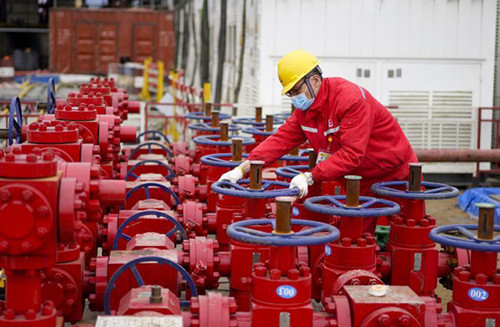
. > TOP STORIES
China’s economic growth to remain on track
Author : WANG YOURAN, WANG XIAOZHEN and ZHAO YUAN Source : Chinese Social Sciences Today 2020-02-27

Despite the short-term impacts of the ongoing COVID-19 epidemic, China’s economic growth will still be on track in the long run, according to experts.
Yan Liang, an associate professor of Economics at Willamette University in the United States, said that the coronavirus outbreak may cause the growth rate to dip to 3% to 4% in the first quarter.
Liang estimated that as long as the epidemic reaches a turning point by the end of February and is well under control by March, the annual economic growth of China is still likely to reach around 5%. Though lower than the country’s growth rates before, the estimated figure is still higher than the global growth rate of around 3%. This is a new normal for China as it furthers its economic transition towards more sustainable and inclusive development.
China’s economy will soon recover once the epidemic is under control, said Ilan Noy, chair in the Economics of Disasters at the Victoria University of Wellington in New Zealand. Noy pointed out that what’s more important is to help people overcome fear. The Chinese government has taken measures to strictly control the spread of the virus and increase information transparency, both of which effectively help reduce public fear. When the epidemic is over, it is essential to figure out how to help businesses and industries to recover in Hubei Province and other hard-hit places.
Hanming Fang, a professor of economics at the University of Pennsylvania, said that the main task of China’s economy in the first half of the year is to win the battle against COVID-19. The country must strike a balance between the needs of contagion control and a resumption of production. Efforts should also be made to protect small and medium-sized enterprises (SMEs).
When the economy returns to a stable level, China will face the challenges and opportunities presented by the China-US phase-one trade deal. Based on a stable economy, Fang noted, China should carry out large-scale reform that focuses on dividing the functions of the market and the government and by deepening market reform.
Fang added that China contributes greatly to the global economy, as is shown by China’s large number of?outbound tourists, as well as its large-scale imports of energy and agricultural commodities. The world still relies on the intensive industrial chain in China. Nevertheless, if the epidemic lingers on, it is inevitable that some multinationals will start to shift their industrial chains out of China, bringing new impacts on China’s industrial chain advantages. The country must prepare.
China now faces more trade barriers and higher cost of labor. The environmental and health costs in domestic production are becoming explicit. All of these require China’s economy to shift to a new growth model that builds on innovation and entrepreneurship and targets the enhancement of domestic demands and standards of living.
To boost domestic demand, an institutional guarantee is needed and many systems must be improved, including the land use system in rural areas, the social insurance system and the social redistribution system, Fang continued. To improve people’s living quality, the government should change the administrative mode that revolves around economic growth. To encourage innovation and entrepreneurship, it is essential to create a level playing field for SMEs, large enterprises and state-owned companies. Meanwhile, it is also important to protect intellectual property rights. There is still a lot of room for reform for China in every aspect mentioned above, Fang concluded.
Hong Yongmiao, dean of the School of Economics at Xiamen University, said that now that China and the US have signed the phase-one trade deal to pause the trade war, both China and the world economy face fewer uncertainties in the short term, which benefits everyone.
Plenty of evidence suggests that the game between China and the US has just begun, which covers many areas ranging from trade and investment to intellectual property rights and more. Therefore, in the year following the phase-one trade deal, China needs to plan ahead and adopt risk management strategies for trade and investment, including risk diversification and risk transfer.
Although increasing exports to the US can help reduce the epidemic’s impact on China’s economy in the short run, it is more important to develop core technologies through independent innovation.
Ye Shengtao made Chinese fairy tales from a wilderness
Ye Shengtao (1894–1988) created the first collection of fairy tales in the history of Chinese children’s literature...
-
How northern ethnicities integrated into Chinese nation
2023-09-18
-
Mogao caves
2023-09-12
-
Mogao Grottoes as ‘a place of pilgrimage’
2023-09-12
-
Time-honored architectural traditions in China
2023-08-29
-
Disentangling the civilizational evolution of China
2023-08-28
-
AI ethics in science fiction
2023-08-23













 2011-2013 by www.cssn.cn. All Rights Reserved
2011-2013 by www.cssn.cn. All Rights Reserved